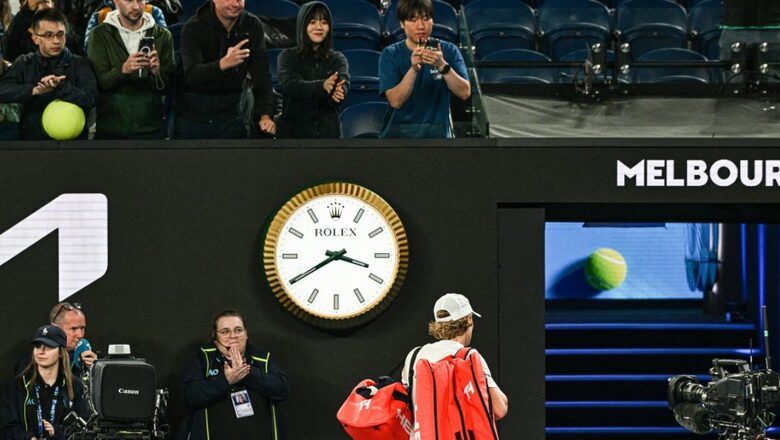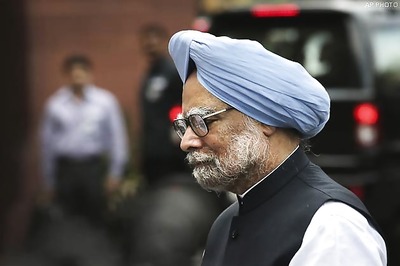
views
A smile creased Daniil Medvedev’s face as he walked to the net in Rod Laver Arena at 3:39 a.m., finally a winner in the Australian Open’s second round after five sets spread across nearly 4 1/2 hours in the third-latest finish in Grand Slam history.
Zero chance Medvedev would have been there at that time if he didn’t need to be. If he were one of the spectators in the nearly empty stands, and a match stretched past, say, 1 a.m., the 2021 U.S. Open champion said, “I would be like, ‘OK, let’s go home. We’re going to catch the end of the match on the TV. Going to watch 30 minutes, then go to bed.’”
So why were Medvedev, a two-time runner-up at Melbourne Park, and the man he beat 3-6, 6-7 (1), 6-4, 7-6 (1), 6-0 in a match that began there Thursday and concluded Friday, Emil Ruusuvuori … and the chair umpire … and the ball people … and the (few) spectators who remained still awake so late?
That’s not the sort of thing that happens in other sports.
“No one should be playing tennis at 3:30am. This is looney tunes,” was a sentiment expressed by John Isner on social media and surely shared by others. Isner, of course, knows a thing or two about playing forever: He won the longest match in tennis history, an 11-hour, 5-minute marathon spread over three days at Wimbledon in 2010.
WHY DO SOME TENNIS MATCHES FINISH SO LATE?
First of all, there’s no such thing as a “game clock” in tennis, in general, and no such thing as “too late” at the Australian Open and U.S. Open, in particular. They play night sessions at those two Grand Slam tournaments, and have for decades, and if the start of one match happens to be delayed until 10 p.m. or even later — Medvedev and Ruusuvuori began warming up after 11 p.m. — they keep playing until someone wins.
In this case, they were pushed back because the match that preceded theirs — Anna Blinkova’s upset of 2022 Wimbledon champion and 2023 Australian Open finalist Elena Rybakina — lasted more than 2 1/2 hours and included a record-setting 22-20 tiebreaker.
It was also a day of ripple effects, because only eight of the 32 singles matches, including one of 16 in the men’s bracket, were done in straight sets (which is two sets for women, who play a maximum of three, and three sets for men, who play a maximum of five).
WHAT ABOUT WIMBLEDON AND THE FRENCH OPEN?
At Wimbledon, the All England Club has an agreement with local residents to halt play at 11 p.m.
Night sessions at the French Open only began in 2021, and while there was a memorable quarterfinal the following year between Rafael Nadal and Novak Djokovic that ended after 1 a.m. — “TV decides. That’s the world we are living in,” Djokovic keenly observed about the late start of that one — it’s yet to have the sort of bleary-eyed finishes that Melbourne and New York produce semi-regularly.
The four latest Grand Slam finishes happened in Australia — 4:34 a.m. is the record, for a 2008 match between Lleyton Hewitt and Marcos Baghdatis — and No. 5 came at the U.S. Open, a 2022 victory for Carlos Alcaraz over Jannik Sinner that wrapped up at 2:50 a.m.
ARE PLAYERS OK WITH THIS?
Not really.
“If we’re going to be honest with ourselves, what are people looking for? They’re not looking for five-hour matches. … I haven’t been able to sit through one,” two-time Australian Open champion Victoria Azarenka said. “It’s just too long.”
Andy Murray, owner of three Grand Slam titles, won a match that stretched beyond 4 a.m. at Melbourne a year ago and is certain that makes zero sense.
“It’s a very obvious thing that needs to change. I haven’t heard anyone really disagree with that,” Murray said.
“Just probably looks a wee bit more professional,” he added, “if you’re not finishing at 3, 4 in the morning.”
Not to mention what it does for the well-being of the athletes and the quality of the competition — during that match and subsequent ones. Both Medvedev and Ruusuvuori were treated by trainers. Medvedev got some help from the chair umpire while tying his shoe at one point. The fifth set was lopsided and not all that entertaining.
“Yes, at night is probably our prime time and we can optimize viewers,” reigning U.S. Open champion Coco Gauff said, “but also, we have to protect the players’ health.”
WHAT IS TENNIS DOING TO CHANGE IT?
The women’s and men’s professional tours announced just before the start of the Australian Open that they’re instituting new rules this month to try to cut back on play after midnight. One problem: Those rules apply only to events run by the WTA and ATP — not Grand Slam tournaments.
Tennis Australia added a 15th day to its marquee event by starting on a Sunday this year, instead of a Monday, which many saw as a grab for more money — but the federation said was intended to add some breathing room to the two-week tournament and reduce the likelihood of late matches. Didn’t quite work out that way.

















Comments
0 comment